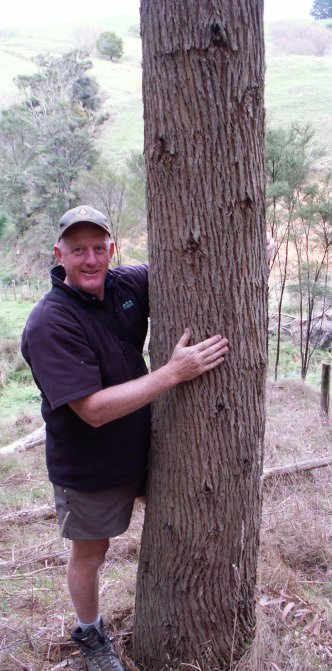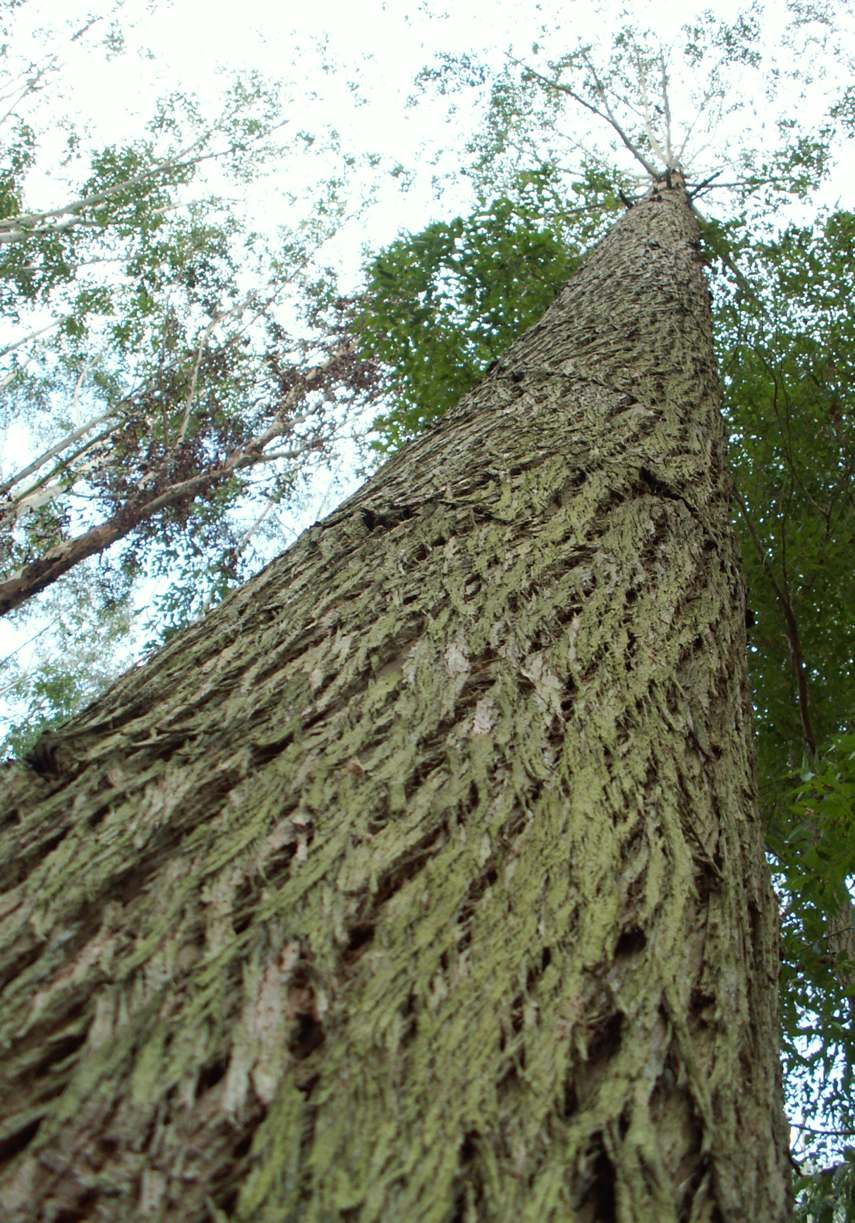Lost durable eucalypt trials, Northland
Saturday, May 24, 2014, Dean Satchell's blog
Tucked away in the back-blocks of Northland are two important research trials of durable eucalypts. These trials have been abandoned by the researchers for some time, as happens repeatedly in forestry. The research is not completed, results are not published and once again nobody learns the lessons these trials offer us. This constantly repeating cycle of reinventing the wheel is all too common in forestry. We do have a difficult industry in that research must focus on the long term, but in practice achieving this has many hurdles to overcome.
The two research trials I'm blogging about are the Eucalyptus pilularis and E. muelleriana species and provenance trials. These two species hold promise for industry because they are both durable hardwoods with considerable potential for a range of high-value applications.
We aren't growing these species on any commercial scale because we simply don't know enough about them to be confident that they are profitable plantation species. What we do know, though, is that the timber is superb. If we could grow them, they are most certainly worth growing for timber. We know these species mill extremely well with little end splitting or movement, we know they season easily with negligible collapse, low shrinkage and are stable timbers in service. We know the logs have very little if any compression core and we know the sapwood content is extremely low and is resistent to lyctus borers.
These are quality hardwood timbers suitable for high-value end uses such as flooring, joinery, outdoor decking and furniture, and even on-farm uses such as cattle rails and posts.
So why have the research trials been neglected? In my view because there isn't enough leadership and motivation within industry to identify and explore opportunities. Perhaps we have become myopic with our traditional focus in NZ on one species, radiata pine.
The species trials
The Eucalyptus muelleriana provenance trial was planted in 1993 on rolling fertile pastoral hill country with clay loam soils. The Eucalyptus pilularis provenance trial was planted in 1997 on a separate site, also rolling fertile hill country with clay loam soils and in pasture.
Angus Gordon, Tim Rose and myself visited both of these trials in May 2014 and assessed the health, growth and form of the trees.
Eucalyptus pilularis trial block
For a long time I have been preaching that form is a real issue with growing E. pilularis, except where the site is sheltered. In my view E. pilularis just doesn't grow straight enough for profitable commercial forestry. Sure enough, only about 1% of the trial trees in this trial were of really good (i.e. perfect) form with no sinuosity and a central leader all the way to the very top of the tree, and only 50% were what I'd class as useable. A big hurdle, but not one that can't be overcome. Useable trees do yield enough volume of sawlogs to have some value, just not optimum or what I'd like to see. Starting with a higher initial stocking would help - I recommend 1600-2000 sph.
Growth rates were superb, we estimate at least 90% of the growth of the adjacent radiata pine planted at the same time.
 |
|
Well known tree hugger Angus Gordon |
Health
Health was okay, but the crowns were looking a bit thin, probably because only one small area of the stand has been thinned. The original 3x4 spacing results in tall trees without much crown volume. However, E. pilularis is a monocalypt and we can expect only limited damage from leaf feeding insects, with the added bonus that they are not favoured by possums.
Form
The biggest problem with pilularis is "sinuosity". The trunk gets "a wobble on", most likely caused by fast growth and wind. This is a bit different from the case where the leader has been damaged and a branch takes over as the new leader, which causes similar deviation in form. Sinuosity is caused by the leader not being stable enough to stay straight while growing. We saw both, but this general sinuosity of the stem is the big issue for this species. We also saw plenty of trees with poor form resulting from damage to the leader. This might be caused by cicadas or wind, but is to be expected and overall loss of form caused by damage is acceptable. The value loss caused by sinuosity is not. On the bright side, there were a couple of provenances that had acceptable levels of sinuosity and show potential. We also anticipate that selection and breeding will overcome these high levels of sinuosity.
Growth
No complaints here. The usual variation in growth is to be expected from unimproved seedlines. On average there wasn't much difference between radiata pine and E. pilularis in terms of tree diameters on this site.
Other species
Yep, ForestResearch couldn't help themselves. They planted Eucalyptus nitens (shining gum) and E. fastigata (brownbarrel) in this Northland trial. They're still saying the best growth for fastigata is in Northland, but clearly they are only measuring young trees. We saw several dying and lots of dead trees at year 17.
There isn't a nitens alive now, and about half the fastigata have died. These are not species to be planting in Northland, it is way too warm here for them. We have many high quality species that grow well so why plant these when they produce much lower quality timber? They are both cold-climate eucalypts and should really only be sited in frosty southern climes where warm-climate eucalypts don't grow.
The photo below has the nitens in the foreground and the pilularis behind.

 |
 |
|
E. pilularis thinned a year or two ago at approx 15 years showing very little end-splitting and about 1 cm of sapwood. |
E. fastigata showing rot that was present in the tree when it was thinned (Lloyd Gravatt pers. comm.) |
 |
| Nearer to the ridge top, form deteriorates where it catches the wind. |
 |
|
Nearer to the bottom of the slope form is much better for the same provenance |
 |
| Prime crop tree suitable for breeding selection |
Eucalyptus muelleriana trial block
This site has trees approaching 21 years of age and is on fertile clay loam soils, again in Northland hill country. Form improves down the slope from the windy ridges. The volume of wood is high and because the trees weren't thinned on time and remain at a fairly high stocking, harvest might need to be delayed for another 10 years.
Health
Health was okay, but again the crowns were looking a bit thin as the stand hasn't had much thinning over the years. E. muelleriana, being a monocalypt, means we can expect only limited damage from leaf feeding insects, with the added bonus that they are not favoured by possums.
Form
Again, general sinuosity of the stem in unimproved seedlines appears to be the biggest issue in terms of stand quality and value. We saw plenty of trees with poor form that likely resulted from damage to the leader. This might be caused by cicadas or wind, but is to be expected and overall loss of form caused by damage is acceptable and an area for improvement. Despite unimpressive form, in my opinion this stand is likely to yield greater returns than if it were in radiata because almost everything can be used.
Growth
No complaints here. The usual variation in growth is to be expected from unimproved seedlines. On average there wasn't much difference between radiata pine and E. muelleriana in terms of tree diameters on this site.
 |
| John Pedersen among his 20 year old trial trees. |
Summary
Selection of the very best trees and using these for breeding is essential to commercialising these species. Hardwood forestry in New Zealand, and certainly in Northland, is a commercial proposition well worth pursuing. A grafted seed orchard would be a good place to start.
NZFFA members can access the E. pilularis and E. muelleriana archives where we have more information on these trials.
Disclaimer: Personal views expressed in this blog are those of the writers and do not necessarily represent those of the NZ Farm Forestry Association.

No posts yet
Add a post